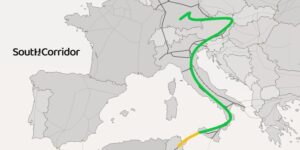You may if you have heard of the “little Russian green men.” They were the “civilians” who supposedly took up arms against the government of Ukraine in 2014 to “liberate” Crimea and the east of the country.
However, in reality these little green men from Russia were not armed civilians, they were a mixture of unidentified soldiers and mercenaries trained to act in conflicts without giving attribution to the government of Russia. An example of “hybrid warfare” that will be explained further below.
Only now, the same thing is happening in the South China Sea. Seemingly civilian fishermen are interfering with US navy ships and those of neighboring countries with rival territorial claims.

China is using a large number of irregular maritime militias, dubbed “little blue men,” to assert and expand its control over a growing area of disputed and claimed islands and reefs in the strategically important South China Sea.
The militias, composed of hundreds of fishermen and motorboats mainly based on Hainan Island, south of the mainland, have been involved in clashes with fishermen, the coast guard, and even the navies of other countries in the region.
By using ostensibly civilian vessels and personnel, China is avoiding direct confrontations between military forces and gaining an element of denial (saying it is not involved in the friction).
How does China’s “hybrid warfare” in the South China Sea work?
Hybrid warfare is a military strategy that employs political warfare and blends conventional warfare, irregular warfare, and cyber warfare with other methods of influence, such as fake news, military disguised as civilians, diplomacy, and interference in foreign elections.
By combining kinetic operations (active military operations) with subversive efforts, the aggressor aims to avoid attribution or retribution because the rival attacked via hybrid warfare has difficulty proving that it was actually attacked by the enemy and thus has difficulty responding militarily.
In the case of China’s hybrid warfare with its fishermen’s militia, some of its fishing vessels and coast guards act aggressively and unprofessionally in the vicinity of other countries’ military forces or fishing vessels with the aim of establishing a narrative of confusion and denial about the dispute.
These activities are designed to stay below the threshold of the conflict level, thus making it impossible for adversaries to accuse China of armed aggression and respond militarily. However, these hybrid aggressive activities gradually demonstrate and assert Chinese claims over territories that other countries dispute.
Naval warfare experts say that such behavior exploits “gray areas” where the military rules of engagement of the U.S. Navy and other countries avoid harsh countermeasures.
Chinese tactics have been compared to those of Russia during its 2014 intervention in Crimea and Ukraine, when armed forces without clear identification, known as “little green men,” were unofficially deployed in the region by the Russian government.
China is trying to use these Chinese government-controlled fishermen “under the curtain” to get the bonus – territory and adversarial destabilization – without the onus of supporting its claims in the South China Sea.
Why is Chinese “Hybrid Warfare” in the South China Sea important?
The threat of the “little Chinese blue men” is a phenomenon little known or understood in the United States and by the world at large. While Russia’s little green men in Crimea are widely known, little attention has been paid to the same tactic in the South China Sea.
China continues to employ “assertive” tactics in defiance of regional and international opinion to establish control and build military facilities, including military ports and airstrips that have been expanded over a “vast area” of land reclaimed from the sea or from existing outposts in the South China Sea.
China’s leadership has shown a willingness to tolerate higher levels of tension with other countries in pursuit of their maritime sovereignty claims. China’s strategy is to secure its objectives without compromising regional peace. Peace that has enabled its military and economic development, which in turn has kept the Chinese Communist Party (CCP) in power.
Brunei, China, Malaysia, the Philippines, Taiwan, and Vietnam have overlapping Chinese claims in the South China Sea.
This region is extremely strategically and geopolitically important as it has large reserves of oil, gas, fish, and strategically important shipping lanes.
The US does not take sides in maritime disputes between countries in the region and China, but the US Navy regularly patrols the area to maintain “freedom of navigation” in international waters.
According to the Pentagon, the maritime militias come from China’s fishing fleet, which officially numbers 21 million fishermen and 439,000 motorboats. The best known are based in Hainan province, where local communities have long-standing historical and commercial interests in the South China Sea.
In 2012 for example, there was the Scarborough Atoll incident, when eight fishing vessels challenged a Philippine warship. The fishermen were praised as an “advanced militia unit” by state media after the incident. According to reports, Xi Jinping – general secretary of the Communist Party and Chinese leader – praised them for their actions and encouraged them to build larger vessels, collect information in distant waters, and support the development of “islands and reefs.”
Chinese navy veterans were recruited to train and boost the militias, which were being expanded in other coastal areas. Local fishermen have assisted in more than 250 “law enforcement operations” over the past three years according to Chinese state media.
According to a Pentagon report, the maritime militias were designed to carry out deception and obstruction activities. The militias on board ships are often clearly identifiable. Most – if not all – of them have uniforms. Wearing camouflage uniforms, they would qualify as soldiers. Taking off the camouflage, they become “law-abiding” fishermen.
The same Pentagon report said that, overall, Beijing continues on a path toward greater power projection with more advanced missiles and weaponry and enhanced cyber and space capabilities. The report also accused China of similarly assertive behavior in the East China Sea to prepare for a potential conflict in the Taiwan Strait.






日軍第731部隊旧址_PB121201-e1713902593308-300x224.jpg)












[…] most recent examples are with the China and the South China Sea or Russia-Ukraine, with attacks by soldiers without uniforms attacking the Ukrainian region, for […]
[…] But in recent months, US President Biden has twice mentioned that he would defend Taiwan against China in the event of war, abandoning the norm of strategic ambiguity. One more match near the wick of the powder keg that is becoming the South China Sea. […]
[…] between New Delhi and the West, given the recognition of the strategic importance of the South China Sea, the Strait of Malacca, which are progressively under greater tension due to disputes between China […]
[…] to Washington’s intelligence, Beijing has already militarized islands in the South China Sea, and Chinese President Xi Jinping has ordered his military to be ready to invade Taiwan by […]